Dubrovnik: The Pearl of the Adriatic
The city of Dubrovnik has been on my wish list for quite some time. Honestly, I did not know a lot about the city, until the series of Game of Thrones were released and caught my interest to read more about it. However, after I saw pictures of it, heard stories from friends of mine and read a bit about its history I wished to go there and spend some time in this incredible old city.
Interestingly enough, the city was found in the seventh century by the ancient Greeks that were coming from the city of Ragusa that was besieged by the Slavic tribes. Later in time, the city of Ragusa grew strong and started developing the surrounding land, which led to the creation of the Republic of Dubrovnik. The Republic of Dubrovnik was one of the strongest and most developed republics in the Middle Ages having its own water supply system, created the first pharmacy in the world, which can be visited today and established an orphanage for young children that had no families. The greatness of the republic was growing especially during its maritime journeys when the sailors were bringing all kinds of treasures and resources from all around the world.
The Republic of Dubrovnik was one of the countries that relied on slavery, as the main way of developing its city, but at the beginning of the fifteenth century, it was officially abolished, making it the first country in the world to do that. Unfortunately, the Republic of Dubrovnik was devastated by the Black Death and killed most of its population, but the rulers of the republic decided to build the quarantine hospitals outside of Dubrovnik, so they can prevent the death of all the people living there. This led to the creation of three hospitals outside of Dubrovnik and on a couple of its islands, which are easily accessed today.
Eventually, the strong Republic of Dubrovnik fell under the sovereignty of the Venetian Republic for about a century, but this did not stop it from developing. Actually, its power started ceasing after an earthquake that struck the republic in the seventeenth century. After that, the Ottomans approached its land and the Republic of Dubrovnik started paying an annual payment to them so that they can keep their lands untouched. Finally, after a couple of centuries, the Republic of Dubrovnik became part of the country of Croatia and remained there.
When I visited the city with my best friend, we were lucky enough that there was not any cruise ship, which would mean that the city would be flooded with lots of people. Luckily, when we were there the city was quite calm and free of all the crowds, which made it a very nice place to explore. Even though it was autumn, the city was sunnier and hotter than ever. Thus, my advice is to always check the forecast, wear sunscreen, sunglasses, and hats, because after a couple of hours on the city walls we had burned. Another advice is to always check on the web if there is going to be a cruise ship mooring in the city and if the answer is yes, re-schedule your visit to the city because it will be flooded with lots of people and your trip won’t be so pleasant, as it will be almost impossible to check any of its landmarks.
The old town of Dubrovnik
Our day trip in Dubrovnik started with a stop near the bridge of Dubrovnik at the Vidikovac Lozica viewpoint, which was overlooking the city of Dubrovnik and a couple of Croatian islands. The view early in the morning was quite beautiful and I could see that the city was still kind of sleepy, as the sun was slowly rising up, but it was a very peaceful moment.
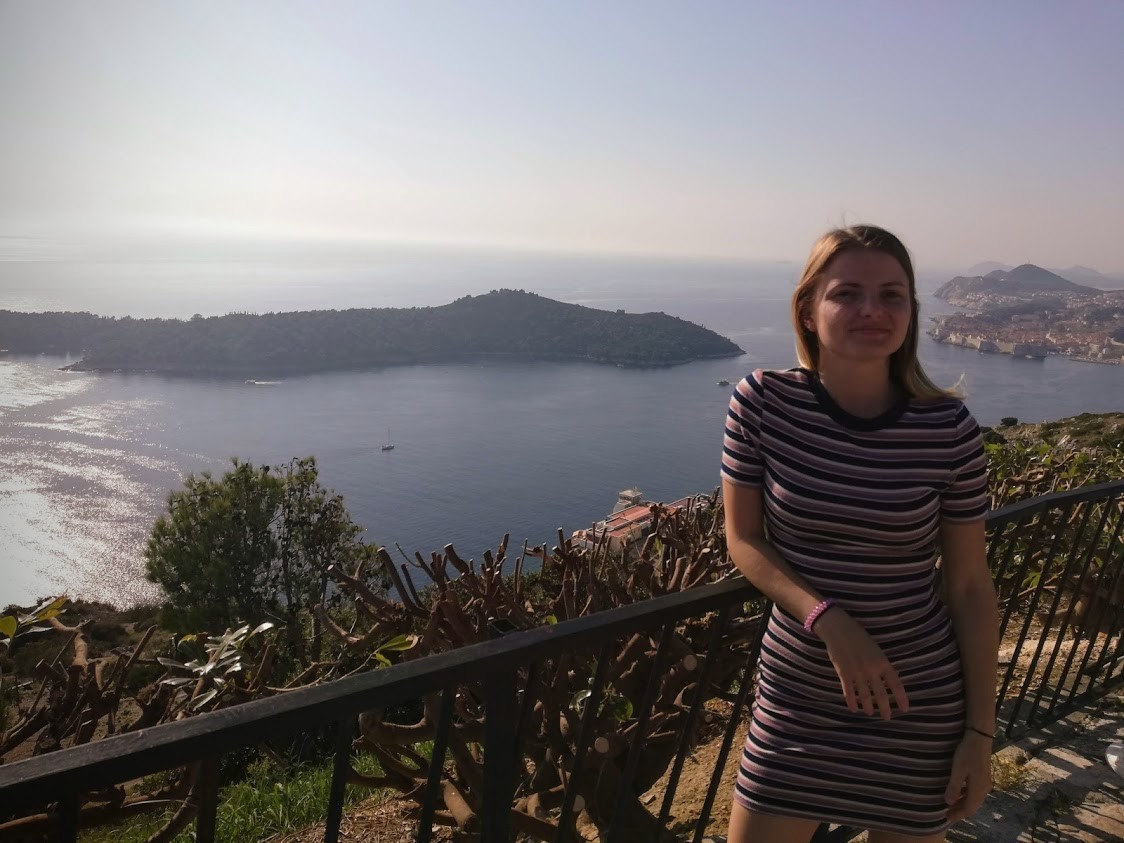
However, when we arrived in the city we stopped right at the Minceta Fortress, which was the starting point of our day trip to Dubrovnik. The Minceta Fortress was built in the north part of the city. Then, we went down the stairs that were leading us to the so-called Pile Gate, which was the main gate leading to the city’s main street called Stradun. The Pile Gate was quite huge, made entirely of stone and getting to it we had to cross an old beautiful stone bridge with carved fences. This was the spot from where we could see the glory of the beautiful city of Dubrovnik, which was entirely walled.
After we entered the old city of Dubrovnik, through the Pile Gate we found ourselves at the Big Onofrio’s fountain, which was used as the main source of fresh water back in the days when the city was relying on its resources. However, before the city had its fountains and water supply system, it relied mainly on water cisterns that were gathering rainwater. After that, with the development of the city and its growing wealth a water supply system was built, so that they can supply the city with fresh water.
The Onofrio’s fountain looked like a big stone cistern with many little fountains with gargoyle heads from which fresh water is pouring. The Big Onofrio’s fountain was full of people everywhere and seemed like a famous spot for gathering. On its left side, there was a tourist information office and we went there, so we can get a map of the old city and some more information about it.
Following the instructions on the map, we went to the left side of the main street Stradun where we found the Franciscan Monastery, which was one of the oldest monasteries in Croatia, built around the fourteenth century. The price to enter was four euros, but unfortunately, it was closed for visitation at this point in the day. I kind of regret this, as it was also housing the oldest pharmacy in Europe, which I wanted to see.
Eventually, we continued further on the limestone-paved Stradun street, which was full of gift shops, restaurants, cafes and sweets shops. While walking on the streets we decided to explore the city a bit further and went to a couple of nice narrow hilly streets either on its right or left side. There we found lots of nice views, old houses, lots of flowers and strange trees, which were like glued to the houses. Those streets truly show the beauty of the city and pass on its incredible vibes. Thus, make sure to get lost in those streets in Dubrovnik and you might find some awesome places there!
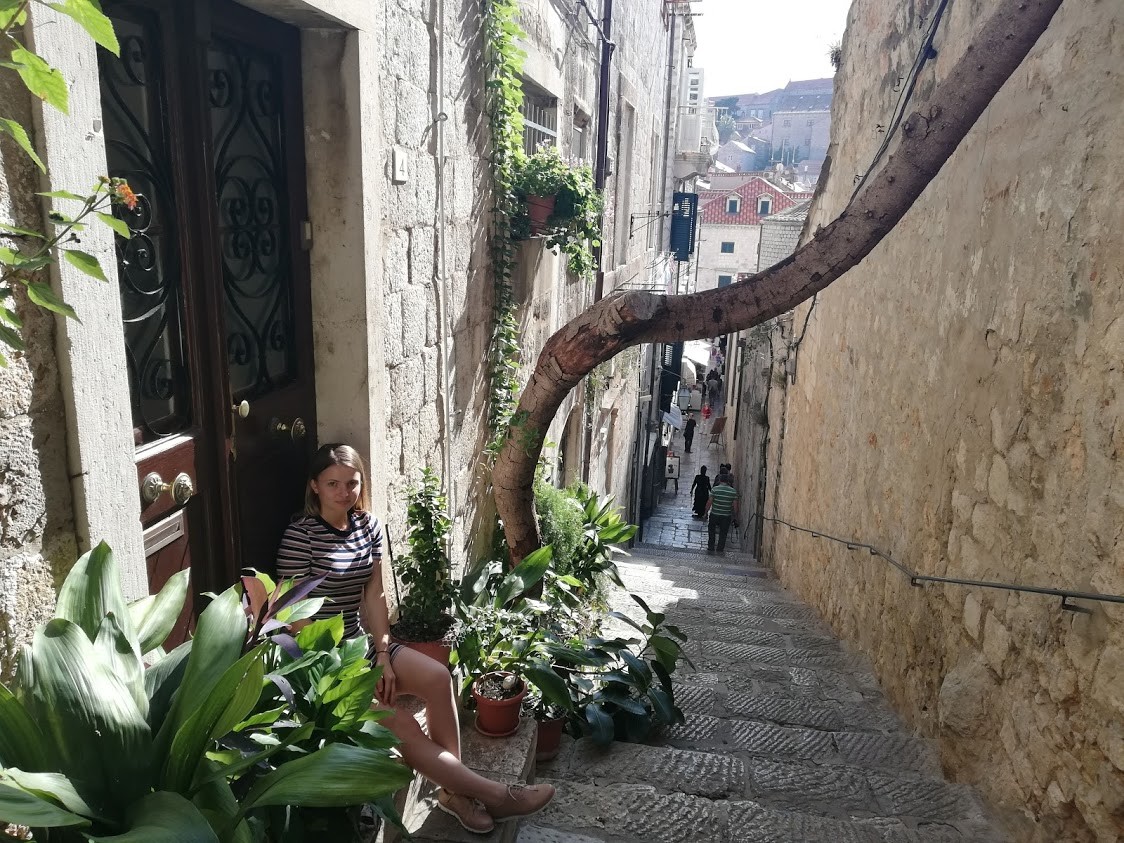
Eventually, we got back at the main street in Dubrovnik and continued to its main square, where was the Church of Saint Blaise. The church of Saint Blaise, which was a church built over another church that was destroyed around the fourteenth century. However, the church was rebuilt around the eighteenth century and inside of it, there was one statue that was kept from the previous church. The church of Saint Blaise had a very beautiful altar made out mostly of gold and there were some frescoes around it adding to its beauty.
Right outside of the church of Saint Blaise is the Column of Orlando, which represents the freedom of the Republic of Dubrovnik. The column was built around the fourteenth century after the brave knight helped the people of Dubrovnik defeat their attackers and keep the city’s freedom.
In front of the Column of Orlando is the Sponza Palace, which was built around the fifteenth century and kept its original form throughout the ages. We knew we were heading to the palace, as we saw the beautiful arches it had all around its entrance. It was not a huge palace, but a very small one that was housing the treasury of the Republic of Dubrovnik back in the days. Anyway, to enter the palace it cost ten euros, but we did not have enough time, so we decided to skip it, although it had a lot of artefacts dating back to the tenth century that was of utmost importance for the city.
Next to the Sponza palace, was the beautiful Clock Tower of Dubrovnik, which was a very tall and elegant tower, built in the Middle Ages. It was also one of the highest buildings in the city and was built next to the gate leading to the port of Dubrovnik. A very interesting fact is that if you would like to hear the bell’s ringing you can visit the tower at noon.
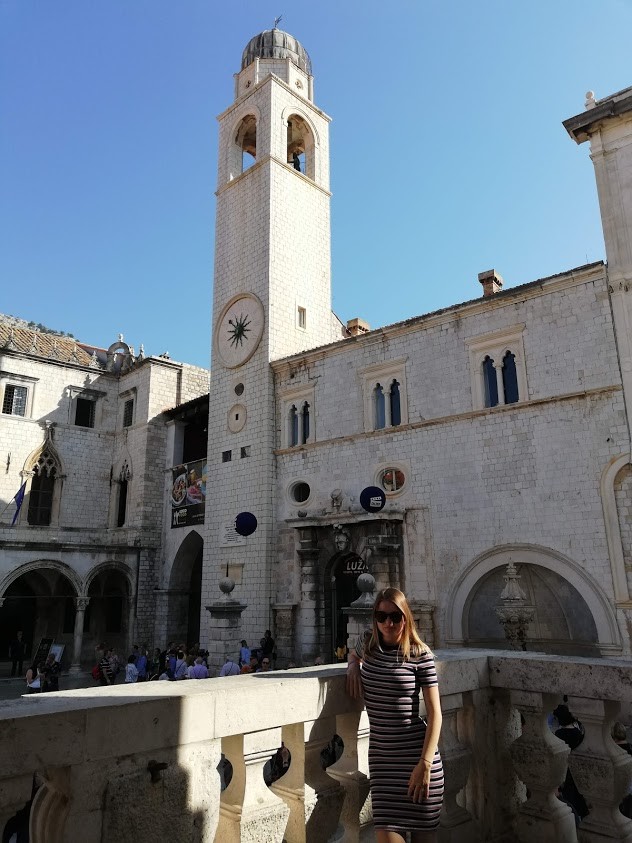
Finally, we went through the gate that was leading to the port of Dubrovnik. There we also saw the old port of Dubrovnik that was to the right side and the new port that was to the left. We stayed there for a while and was offered a ride to the island of Locrum, which would cost us around twenty euros, thus we turned the offer down. However, we got to know that there we can see the throne from the Game of Thrones, but we did not have so much time and also money, thus we stick to our plan and went back inside of the city and to the Walls of Dubrovnik.
The Notorious Walls of Dubrovnik
The entrance to the Walls of Dubrovnik was next to the Pile gate and from there we could buy our tickets that would cost us 7 euros, which was the price for students. However, the regular ticket was quite high and cost around 27 euros, so we were quite lucky.
Thus, we started our journey up the stairs that brought us exactly at the city walls, which were quite high. The notable Walls of Dubrovnik were built around the thirteenth century after the city was besieged many times and even occupied. After it regained its freedom its people started the development of the city walls that encircled the whole city. However, there were a couple of gates that were built along with the walls, so that the export and import of goods to the city does not stop. The most famous gates in the city were the Pile gate, which was the main gate to the city and the Ploce gate which was on the east side of the city and resembled a lot the Pile gate.
Anyway, once we got up the walls we were simply stunned by the view that we were lucky enough to witness. Honestly, the view from the walls over Dubrovnik was simply breathtaking! From there we could see the all-red roofs of the houses that were everywhere, the Clock tower of Dubrovnik, that was standing high, the Franciscan monastery, the churches of the city, the Mediterranean Sea and the fortresses of the Dubrovnik. I could not believe my eyes! This view was simply amazing!All these bright colours everywhere that perfectly complimented each other.
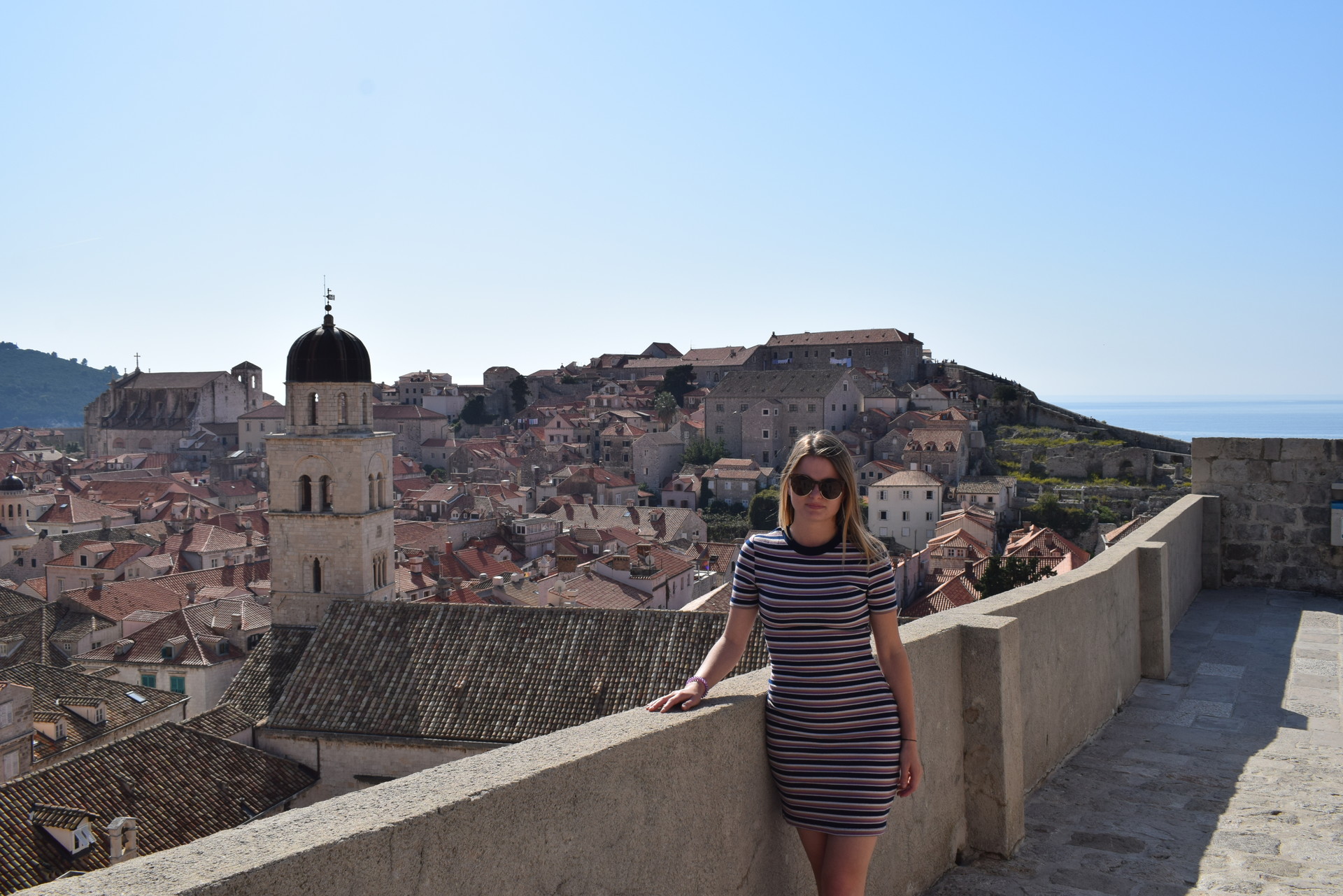
After staring for a bit we went up the walls and to the Minceta Fortress, which was put at the highest hill in the city. It was all round and spacious inside and we had to climb some stairs to get on its top and overlook the city from above. At the top, there were many places where the archers were protecting the city from any invaders. The view from the fortress of Minceta was also allowing you to overlook all over the city, the Mediterranean Sea and the surrounding land. Thus, it was a very good spot for protecting the city from any kind of threat.
In addition to that, after we went down the stairs we could walk around the fortress' safe place from where the city was also defended. The interesting fact is that at this place a scene of Game of Thrones was shot where Daenerys is searching for her stolen dragons. Thus, for a loyal fan like me, this was for sure must-see!
Then, we went to the west part of the walls of Dubrovnik, where were the other forts – Bokar and Lawrence, which were supposed to protect the city from any marine invaders. Going to the east part of the walls we saw lots of houses where people were still living in them and seemed unbothered that the walls were exactly in their yard.
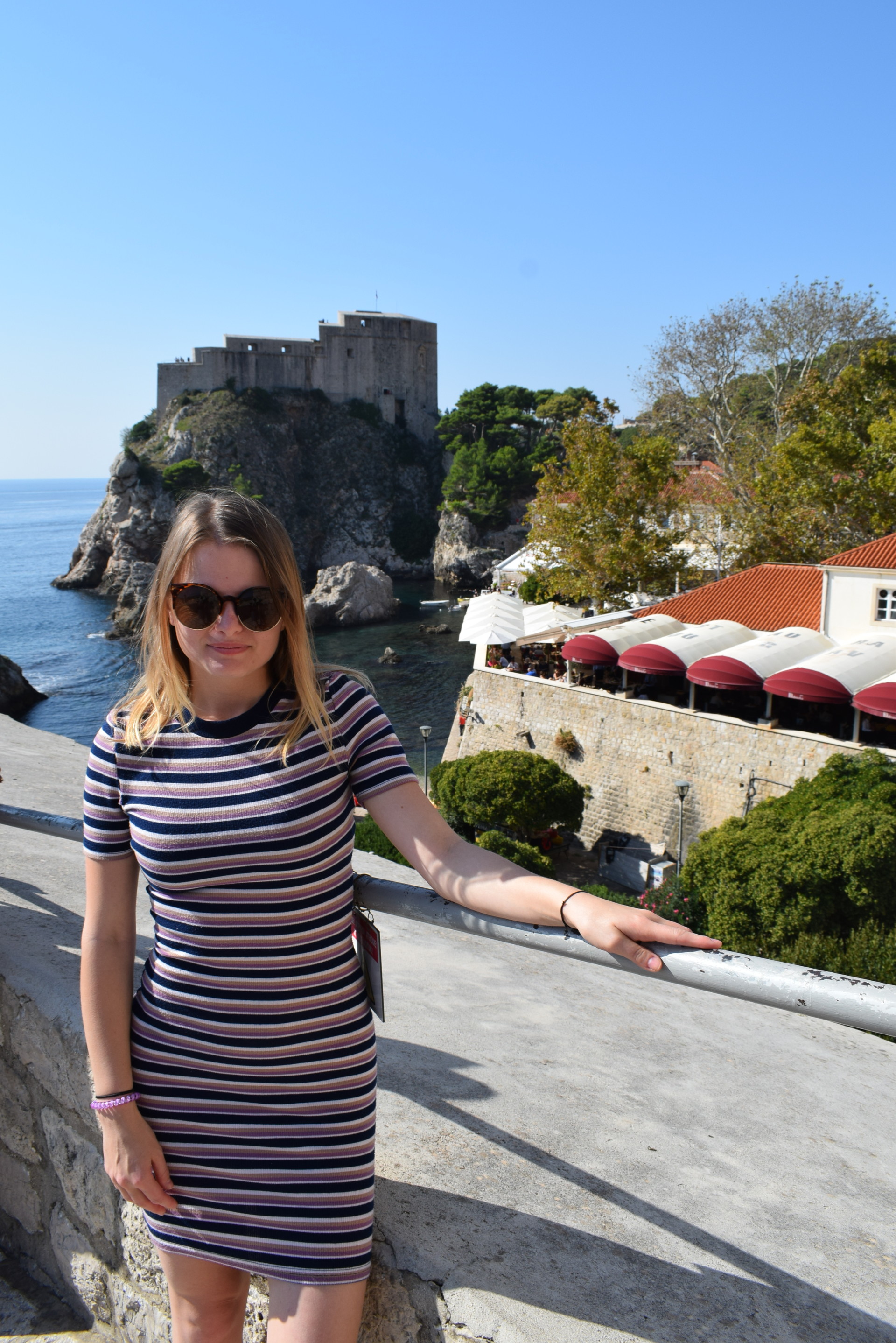
Eventually, we reached the easternmost part of the walls of Dubrovnik where we found the last two forts the Revelin and the fort of Saint John from which we could overlook at the old harbour of Dubrovnik.
Eventually, after walking for around two hours around the walls of Dubrovnik we went back to the old city. There we realized that we were quite sunburned and also hungry and thirsty, thus we started looking for a nice restaurant to get something to eat and drink after this exhausting walk up the walls. So we ended up at Taverna Pupo, where we ordered some ice cold water and tuna burgers, which were quite small, but very delicious and fulfilling.
Overall, my trip to Dubrovnik was quite memorable and filled with positive emotions and great vistas everywhere. This city is quite amazing and is worth a visit for sure, so if you get the chance, do not hesitate and stop by!
Photo gallery
Content available in other languages
- Español: Dubrovnik: la joya del Adriático
Want to have your own Erasmus blog?
If you are experiencing living abroad, you're an avid traveller or want to promote the city where you live... create your own blog and share your adventures!
I want to create my Erasmus blog! →




















Comments (0 comments)